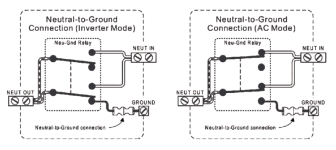I would use an automatic transfer switch:
Here is an example. Magnum is well thought of in the inverter world.
A 30 amp auto transfer switch is here
A few other thoughts: What batteries are you going to use and where are they going to be located? Be sure that the water heater and battery charger are not on the auto transfer switch current. If you are going to run both the inverter and microwave, at the same time, then you will want a 30 amp transfer switch.
You will want at least 100 amp hours usable battery power (either 2 AGM group 31's or one 100 amp LiFePO4 battery, and a way to rapidly recharge the batteries). You will need heavy cables--at least 1/0 up to 4/9 battery cables from the batteries to the inverter.
Then you will have to rewire the 110V plugs that are going to run the induction burner, microwave and refrigerator so they are all going thru the inverter. All of the 110 wiring, should be 12 gauge Marine stranded wire, not romex solid wire as used in household wiring.
I have done this on two boats. There are two ways to do it. The
Tom Cat, I just put in split 110 V 15 amp outlets, so that when I was on inverter power, I used one side of the 110 V outlet, and mains power the other side. this gets away from completely re-wirng the boat. On my current
25 C Dory, I am using a 2000 Watt PSW Victron Inverter/80 amp charger/50 amp power booster, which has a built in transfer switch. (Much easier to use an inverter with built in transfer switch.)
In the latter case, I too power from the main 110 V panel, off the "outlets" and ran it to the inverter. then I ran the wire back to the main panel, where the inverter is now hooked up to all ov my 110 V outlets (except the air conditioner, Battery charger and water heater are all on separate 110 V circuits from the main power panel.
The Tom Cat I put in 2 AGM group 31 batteries about 2 feet from the inverter. The C Dory 25, I have 2 Battle Born, 100 amp hour LiFePO4 batteries. I found that I needed ore than 100 amps usable. I also run 12 volt refrigeration (two top loading chests; one a freezer and the other a refirgerator.).
Your way is very similar to what I did with the Tom Cat. I am not a fan of a the output from an inverter being thru a 110 V duplex outlet. Hard wiring is safer, and I believe to ABYC standards for permeant installation.
For the computer, you are probably better using a small inverter-such as 150 watts. The MacBook only draws about 60 to 85watts depending on model.
The microwave will probably pull 1000 watts. (I know that some microwaves are labeled "700 watts", but that is output, not input. If you don't already own a
Kill-A-Watt meter buy one. It will show the power draw of any appliance, in watts, amps and cumulative over time watts, plus voltage and hz (cycles).
You also want a shunt type meter for current draw to the inverter. The Victon 702 or 712 (blue tooth to I phone, makes it slightly easier to use). I don't know what the charging output of your Yamaha outboards are--but it will need all of the power to recharge the inverter battery bank.
Draw out your circuit before you start running wiring.

